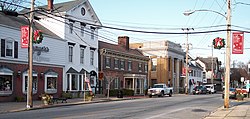Smyrna, Delaware
| Smyrna, Delaware | |
|---|---|
| Town | |

South Main Street in Smyrna
|
|
| Etymology: Ancient Greek seaport of Smyrna | |
 Location in Kent County and the state of Delaware. |
|
| Location within the state of Delaware | |
| Coordinates: 39°17′59″N 75°36′17″W / 39.29972°N 75.60472°WCoordinates: 39°17′59″N 75°36′17″W / 39.29972°N 75.60472°W | |
| Country | United States |
| State | Delaware |
| County | Kent, New Castle |
| Area | |
| • Total | 3.8 sq mi (10 km2) |
| • Land | 3.7 sq mi (10 km2) |
| • Water | 0.1 sq mi (0.3 km2) |
| Elevation | 33 ft (10 m) |
| Population (2010) | |
| • Total | 10,023 |
| • Density | 2,637.6/sq mi (1,018.4/km2) |
| Time zone | Eastern (EST) (UTC-5) |
| • Summer (DST) | EDT (UTC-4) |
| ZIP code | 19977 |
| Area code(s) | 302 |
| GNIS feature ID | 214671 |
| Website | www.smyrnadelaware.com |
Smyrna is a town in Kent and New Castle counties in the U.S. state of Delaware. It is part of the Dover, Delaware Metropolitan Statistical Area. According to the Census Bureau, as of 2010, the population of the town is 10,023.
The international jurist John Bassett Moore was born in Smyrna, as were politicians Louis McLane and James Williams.
Smyrna was originally called Duck Creek Cross Roads and received its current name in 1806 after the Ancient Greek seaport of Smyrna in present-day Turkey. The town was located along the north-south King's Highway. Smyrna was originally a shipping center along the Duck Creek and was the most important port between Wilmington and Lewes, shipping grain, lumber, tanbark, and produce to points north. After the shipping industry collapsed in the 1850s, the town would continue to be an agricultural center.
The Bannister Hall and Baynard House, Belmont Hall, David J. Cummins House, Timothy Cummins House, Duck Creek Village, George Farmhouse, Ivy Dale Farm, Mount Pleasant, Moore House, Peterson and Mustard's Hermitage Farm, Savin-Wilson House, Short's Landing Hotel Complex, Smyrna Historic District, John M. Voshell House, and Woodlawn are listed on the National Register of Historic Places.
...
Wikipedia


